By Guy Gallez
The idea to develop a census template came to me after a member of TBR volunteered to help retrieve the Belgians who lived in Michigan in 1930, using the microfilm images available for free at www.archive.org.
A quick look at the number of microfilms to view (106 total), each approximately 1,100 pages long, convinced me not only of the enormity but also of the impracticability of the task at hand. So I suggested creating lists of persons using Ancestry.com’s index and see if it was possible to link this information with the microfilms available at Internet Archive.
After much stumbling I found a system which, although far from perfect, makes it realistically possible for someone with internet access to help move this project forward.
I added the link to the microfilm # and to the corresponding page within the microfilm. However, although the link to the microfilm causes no problem, the link to the page number is something else. I kept the Ancestry page # but there is a discrepancy in matching with Internet Archive. The matching page for a particular entry is usually not too far from the given number, at most 5 pages ahead or behind the number.
What I did for the 1930 Census for the state of Michigan, I applied to the other states and the other census that we have not done yet, as well. That is how the list of Belgians found in the complete 1880 census is now available on our TBR website. Each web page contains one State/County, the ones with a lot of names are divided further into State/County/Township. Some, particularly in Wisconsin, even covered several web pages.
In the first column, you find the microfilm#
In the second, the (approximate) page where to pull the information for the listed name.
This list covers, not only the people born in Belgium but also those for whom at least one parent was born there.
For those who would like to try themselves at this and help us finish the 1880 census, here is how to proceed:
To transcribe a county or part of one, go to our webpage at http://www.rootsweb.com/~inbr/index.html and pick the census page you want to help with. Copy and Paste into your own Spreadsheet software (Excel, MicrosoftWorks or other)
 Note: if it’s easier for you, just contact me and I will send you the county of your choice, already in a spreadsheet format.
Note: if it’s easier for you, just contact me and I will send you the county of your choice, already in a spreadsheet format.
Important: before beginning, contact me at guy.gallez@gmail.com
It is possible another person has chosen to work on the same county or that the work has already been done.
 Here is what Mobile County, Alabama looks like in Excel2003.
Here is what Mobile County, Alabama looks like in Excel2003.
Only two townships: Mobile and Spring Hill.
The first column gives the reel number and the second the approximate page on which to find the information.
Go to the Internet Archives site (http://www.archive.org/)
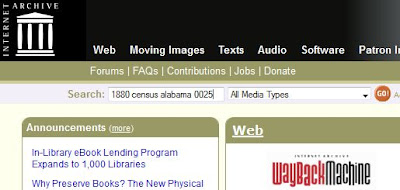
In the “Search” box, type
- the census year
- the word “census”
- the name of the state
- the reel number in 4 digits – so if it’s 25, enter it 0025
So here you would type: 1880 census Alabama 0025
And click “Go”
Your results should show as follows
 Click on the link to obtain the next image.
Click on the link to obtain the next image.
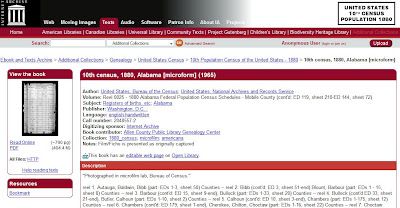
At this point you will be able to choose to:
- Read Online or
- Save as a PDF file
Unless you want to save the file to your computer, the “Read Online” option is fine.
You are now on the roll’s first page.
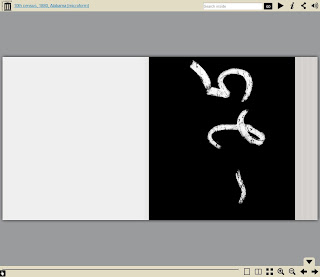
Make sure you choose the ONE page mode rather than 2 (as set as default) so you can better manage the cursor on the page you are looking for. In this case we are looking for.
Here we are looking for page 234
Slide the hand to the right to advance faster to page 234
Zoom in to see better
After looking through the page you should find Leonard Dirke on page 232. As mentioned earlier, usually you will find the name you are looking for within a 10 pages range of the number given (5 ahead, 5 behind). That’s the big drawback in this method as the numbering system used by Ancestry is not exactly the same as the one used by Internet Archives. However once you have found the discrepancy, the difference seem to remain the same all through the reel.
If you need help with this, contact me - guy.gallez@gmail.com. We can look at it together.
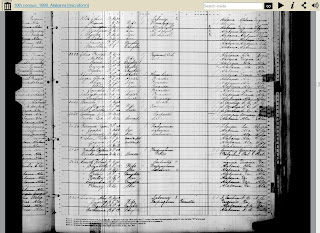
All you need to do after that is to type in the additional information found on the page (and correcting the page number if necessary).
- sex = M ou F
- S = single, M = Married W = Widowed, D = Divorced
- complete the spaces for occupation and birth places
- add the other family members
- possibly correct the spelling of the Name in parenthesis
- add notes if you need to
- insert a blank line to separate each family
- re-order the families as the Ancestry index does not take the order the census was taken in into consideration.
This should give you the end result that follows:
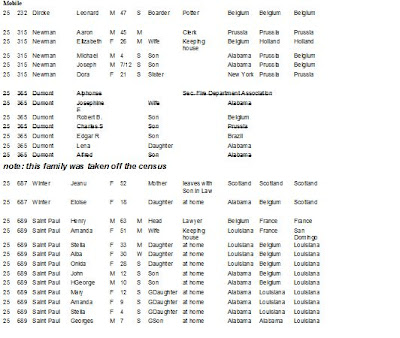 Then all you have left is "Spring Hill" on reel 24.
Then all you have left is "Spring Hill" on reel 24.
Go back to Internet Archives.
Search for 1880 census Alabama 0024 and follow the same procedure.
When you are finished, email me the spreadsheet to be uploaded on the website.
If you run into any trouble, just let me know and we will check it out together.
Thank You for your help!
http://thebelgianresearchers.blogspot.com/








